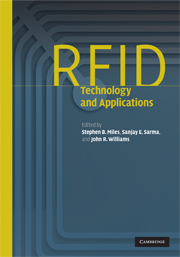Book contents
- Frontmatter
- Contents
- List of contributors
- Preface
- Acknowledgments
- 1 Introduction to RFID history and markets
- 2 RFID technology and its applications
- 3 RFID tag performance optimization: a chip perspective
- 4 Resolution and integration of HF and UHF
- 5 Integrating sensors and actuators into RFID tags
- 6 Performance evaluation of WiFi RFID localization technologies
- 7 Modeling supply chain network traffic
- 8 Deployment considerations for active RFID systems
- 9 RFID in the retail supply chain: issues and opportunities
- 10 Reducing barriers to ID system adoption in the aerospace industry: the aerospace ID technologies program
- 11 The cold chain
- 12 The application of RFID as anti-counterfeiting technique: issues and opportunities
- 13 Closing product information loops with product-embedded information devices: RFID technology and applications, models and metrics
- 14 Moving from RFID to autonomous cooperating logistic processes
- 15 Conclusions
- Appendix – links to RFID technology and applications resources
- Editor biographies
- Index
- References
3 - RFID tag performance optimization: a chip perspective
Published online by Cambridge University Press: 02 November 2009
- Frontmatter
- Contents
- List of contributors
- Preface
- Acknowledgments
- 1 Introduction to RFID history and markets
- 2 RFID technology and its applications
- 3 RFID tag performance optimization: a chip perspective
- 4 Resolution and integration of HF and UHF
- 5 Integrating sensors and actuators into RFID tags
- 6 Performance evaluation of WiFi RFID localization technologies
- 7 Modeling supply chain network traffic
- 8 Deployment considerations for active RFID systems
- 9 RFID in the retail supply chain: issues and opportunities
- 10 Reducing barriers to ID system adoption in the aerospace industry: the aerospace ID technologies program
- 11 The cold chain
- 12 The application of RFID as anti-counterfeiting technique: issues and opportunities
- 13 Closing product information loops with product-embedded information devices: RFID technology and applications, models and metrics
- 14 Moving from RFID to autonomous cooperating logistic processes
- 15 Conclusions
- Appendix – links to RFID technology and applications resources
- Editor biographies
- Index
- References
Summary
From an historical perspective it is the small CMOS integrated circuits (versus inductively coupled transponders) which incorporated microwave Schottky diodes that made it possible to manufacture small passive RFID tags. In this chapter it is demonstrated how recent improvements in CMOS technology (0.18u and later) make it possible to use an inexpensive MOS transistor for the EPC GenII/ISO 18000-6c compliant transponders that operate in the UHF band. The basic variables for designing low-power (high-readability) RFID tags and details of incorporating temperature sensors into semiconductor chip designs at the Auto-ID Labs, Fudan University, Shanghai are described.
This chapter explores chip design principles that affect the performance of RFID tags. The metrics of tag performance will be illustrated and the corresponding optimization technologies will be introduced. Many early implementation issues for RFID tags involved low read rates such that tags did not “wake up” in response to interrogator signals and transmit their IDs, especially with transponders operating at UHF frequencies that are subject to interference from liquids and metals.
Metrics of tag performance
In RFID applications, tag performance will directly influence the success of the whole system. Understanding the metrics of tag performance is important in order to foresee the overall system performance. This section will analyze the metrics of tag performance, including read range, read rate, communication speed, etc.
- Type
- Chapter
- Information
- RFID Technology and Applications , pp. 33 - 46Publisher: Cambridge University PressPrint publication year: 2008



